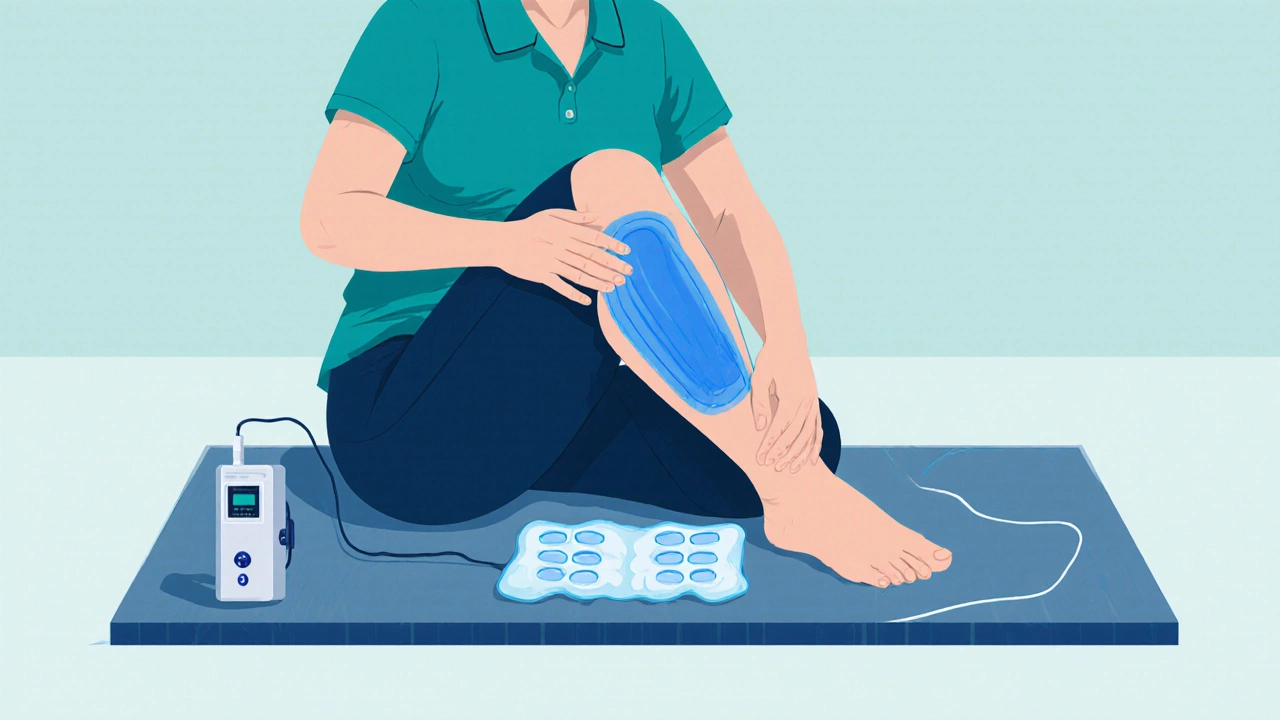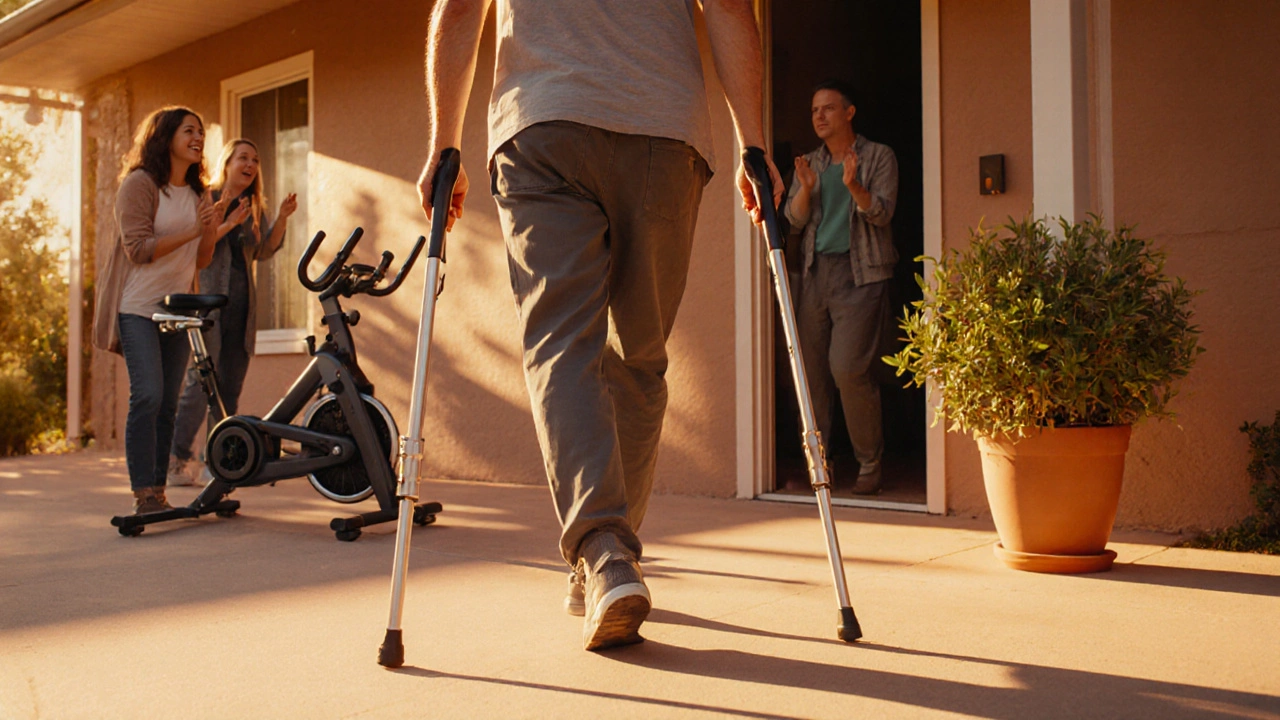Knee Replacement Recovery Milestone Calculator
Track Your Recovery Progress
Your Recovery Timeline
When you walk out of the operating room after a Total knee arthroplasty is a surgical procedure that replaces the damaged knee joint with artificial components, the real test begins: Knee replacement recovery is the post‑surgical period during which pain, swelling, mobility and daily function gradually improve, often taking months to reach a stable state. While surgeons focus on aligning the implant, patients soon discover that the toughest part isn’t the surgery itself but the road to reclaiming a normal life.
Understanding Knee Replacement Recovery
Recovery isn’t a single event; it’s a series of milestones. In the first 24‑48 hours, the priority is pain control and preventing complications. By week two, you’ll start gentle range‑of‑motion exercises. Around six weeks, most patients transition to weight‑bearing activities, and by three to six months, the joint should feel strong enough for low‑impact sports. However, each phase brings its own set of challenges, and the hardest part often varies from person to person.
The Biggest Physical Hurdles
Physical discomfort is unavoidable, but some aspects are universally reported as the most grueling.
- Pain Management - Even with modern multimodal analgesia, many patients describe a lingering ache that spikes with movement. The balance between enough medication for comfort and avoiding dependence is delicate.
- Swelling and Stiffness - Post‑operative inflammation can double the knee’s circumference, making it hard to bend or straighten fully. Stiffness often lasts beyond the first month and can slow progress.
- Regaining Range of Motion - Achieving a functional bend of 110‑120 degrees is essential for daily activities like sitting in a chair. Many patients hit a plateau around 80‑90 degrees, and breaking through requires disciplined stretching.
These three factors are tightly linked; unmanaged swelling fuels stiffness, which in turn amplifies pain.
Hidden Risks That Can Set You Back
Beyond the obvious discomfort, a few low‑probability but high‑impact complications can derail recovery.
Blood clot is a dangerous buildup of blood, often in the deep veins of the leg, that can travel to the lungs (pulmonary embolism). Even with prophylactic anticoagulants, the risk peaks between the second and fourth week. Signs include sudden calf pain, warmth, or shortness of breath. Prompt detection is vital.
Infection is the invasion of bacteria at the surgical site, which can compromise the implant and require revision surgery. Early signs are redness, increased drainage, and fever. While infection rates are under 2%, the recovery extension can be several months.

Functional Challenges in Daily Life
Getting back to regular tasks often feels like climbing a steep hill.
- Walking and Weight‑Bearing - Early on, patients rely on walkers or crutches. Transitioning to unaided walking can be scary, especially on uneven surfaces.
- Using Assistive Devices - Devices such as a knee brace or a raised toilet seat become temporary necessities. Learning to adjust them without compromising the healing joint adds mental load.
- Home Modifications - Simple things like removing loose rugs, adding handrails, or rearranging furniture can prevent falls, but they require planning and effort during a time when energy is low.
Emotional and Mental Strain
Recovery isn’t just physical. Many patients report frustration, anxiety, or even mild depression when progress stalls. The expectation that surgery will instantly restore “normal” can clash with reality, leading to disappointment. Support from family, a therapist, or a support group can make a huge difference.

Tips to Overcome the Hardest Parts
Knowing what’s toughest helps you prepare better. Below are proven strategies to smooth the rough patches.
- Pre‑hab and Preparation - Engage in strengthening exercises for the quadriceps and hamstrings before surgery. Studies from 2023 show that pre‑hab reduces post‑op pain by up to 30%.
- Commit to Physical Therapy - Physical therapy is a structured rehab program that combines exercises, manual techniques, and education to restore function is non‑negotiable. Attend every session, and do the home‑exercise plan religiously.
- Pain Control Strategies - Use a combination of prescribed medication, over‑the‑counter NSAIDs, and non‑drug methods like cryotherapy or transcutaneous electrical nerve stimulation (TENS). Keep a pain diary to discuss dosage adjustments with your surgeon.
- Manage Swelling - Elevate the leg above heart level for 15‑20 minutes, three to four times daily. Compression wraps and intermittent pneumatic compression devices can cut swelling by 40% within the first week.
- Monitor for Complications - Know the red‑flag signs for blood clot and infection. Schedule a duplex ultrasound if you notice calf discomfort, and contact your surgeon immediately if you develop a fever.
- Set Realistic Milestones - Break recovery into weekly goals (e.g., “walk 50 m without crutches by week 3”). Celebrate small wins to keep motivation high.
- Seek Emotional Support - Join a knee‑replacement support group, talk openly with family, or consider brief counseling sessions if you feel overwhelmed.
Recovery Timeline at a Glance
| Week | Milestone | Most Challenging Aspect |
|---|---|---|
| 1‑2 | Pain control, wound healing | Pain spikes with movement |
| 3‑4 | Begin gentle range‑of‑motion exercises | Swelling limiting bend |
| 5‑6 | Start partial weight‑bearing, crutches wean | Fear of walking without support |
| 7‑12 | Achieve 90‑110° flexion, stair navigation | Plateau in range of motion |
| 13‑24 | Full weight‑bearing, return to low‑impact activities | Detecting and preventing blood clot |
| 6+ months | Resume most daily activities, optional sports | Psychological adjustment to new limits |
Frequently Asked Questions
How long does the hardest part of recovery usually last?
The most intense pain and swelling typically peak in the first two weeks, while stiffness and limited range of motion often linger until week six. Most patients report that the psychological hurdle-fear of walking unaided-remains strongest until the third month.
Can I speed up my recovery by skipping physical therapy?
Skipping PT is a short‑term convenience that usually backfires. Research shows that patients who adhere to a structured PT program regain full knee flexion 30% faster than those who do not.
What are the warning signs of a blood clot after knee replacement?
Look for sudden calf pain, swelling that’s different from the surgical leg, warmth, or shortness of breath. If any of these appear, contact your surgeon or go to the emergency department immediately.
Is it normal to feel depression during recovery?
Yes, many patients experience mood swings or mild depression, especially when progress slows. Talking to a therapist or joining a support group can provide coping tools and reduce feelings of isolation.
When can I safely resume low‑impact sports like cycling?
Most surgeons clear patients for stationary cycling around 12‑16 weeks, once they can achieve at least 110° of knee flexion and demonstrate stable gait without assistive devices.
